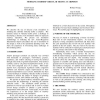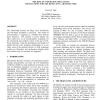WSC
2000
14 years 6 months ago
2000
Discrete event simulation has long been recognized as a valuable tool for manufacturers, but converting the recognition of value into an embrace of the technology can be a challen...
WSC
2000
14 years 6 months ago
2000
This paper describes the development of a traffic-modeling tool as an Arena template and two applications of it: one to evaluate alternative designs for the road network on the pr...
WSC
2000
14 years 6 months ago
2000
In this paper, we present a simulation testbed for wireless and mobile telecommunication systems, a two-stage PCS parallel simulation testbed which makes use of a conservative sch...
WSC
2000
14 years 6 months ago
2000
Discrete Event Simulation (DES) has been used as a design and validation tool in various production and business applications. DES can also be utilized for analyzing the product-m...
WSC
1998
14 years 6 months ago
1998
The use of the World Wide Web and Java-based mobile code provides new opportunities for distributed simulation. First, the infrastructure provided by the Internet eliminates the n...
WSC
1998
14 years 6 months ago
1998
We describe the use of discrete event simulation in modeling the curbside vehicular traffic at airports. The dynamic nature of vehicular traffic poses a challenge in developing a ...
WSC
1998
14 years 6 months ago
1998
The relationship between the High Level Architecture and web-based simulation is discussed. The notion of interoperability is suggested as a binding force between these initiative...
WSC
1998
14 years 6 months ago
1998
The Time Warp protocol is considered to be an effective synchronization mechanism for parallel discrete event simulation (PDES). However, it is widely recognized that it suffers o...
WSC
1998
14 years 6 months ago
1998
A model is proposed which identifies factors associated with the adoption of discrete event simulation and places them within an explanatory framework. The model proposes four mai...
WSC
1998
14 years 6 months ago
1998
MODSIM II is an object-oriented discrete event simulation language featuring extensive run-time libraries, graphical user interface and results presentation tools, database access...




